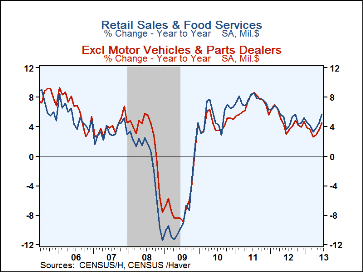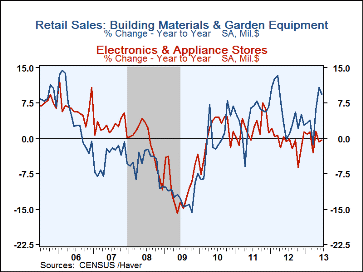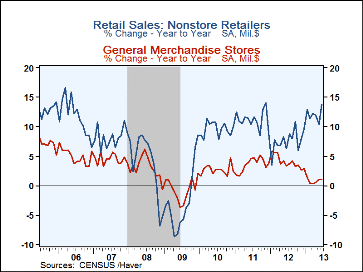 Global| Jul 15 2013
Global| Jul 15 2013U.S. Retail Sales Driven Higher by Durables and Internet Sales
by:Tom Moeller
|in:Economy in Brief
Summary
The consumer remains in a buying mood, but purchases last month were not broadly based. Retail sales increased 0.4% during June (5.7% y/y) following a 0.5% May increase, initially reported as 0.6%. A 0.7% rise had been expected [...]
The consumer remains in a buying mood, but purchases last month were not broadly based. Retail sales increased 0.4% during June (5.7% y/y) following a 0.5% May increase, initially reported as 0.6%. A 0.7% rise had been expected according to Action Economics. Retail sales excluding autos were unchanged (4.5% y/y) after a 0.3% May gain. The latest figure disappointed expectations for a 0.4% rise.
Sales of motor vehicles & parts increased 1.8% (11.4% y/y as unit motor vehicle sales, reported earlier this month, rose 4.2% (11.0% y/y). That gain was offset by a 2.2% decline (9.4% y/y) in building material sales. Gasoline service station sales rose 0.7% (4.3% y/y) as pump prices increased. Spending outside of these three areas is used in calculating gross domestic product, and sales ticked up 0.1% (3.9% y/y) last month following 0.2% increases during the prior three months.
Consumers were shopping the internet last month. Sales of nonstore retailers gained 2.1% (13.8% y/y) after a 0.4% May rise. Elsewhere, sales were mixed. Spending at furniture & home furnishings stores posted a 2.4% rise (4.6% y/y) although sales of electronics and appliances slipped 0.1% (-0.3% y/y). Clothing store sales rose 0.7% (4.8% y/y) but purchases at general merchandise stores nudged up just 0.1% (1.1% y/y). Health & personal care store sales rose 0.2% (3.0% y/y) yet food & beverage store sales slipped 0.1% (+0.3% y/y). Consumers became less inclined to eat out. Food service and drinking place sales fell 1.2% (+3.1% y/y) following a 0.6% May decline.
The retail sales figures are available in Haver's USECON database. The Action Economics figures are in the AS1REPNA database.
| Retail Spending (%) | Jun | May | Apr | Jun Y/Y | 2012 | 2011 | 2010 |
|---|---|---|---|---|---|---|---|
| Total Retail Sales & Food Services | 0.4 | 0.5 | 0.2 | 5.7 | 5.3 | 7.5 | 5.5 |
| Excluding Autos | 0.0 | 0.3 | -0.0 | 4.5 | 4.8 | 7.0 | 4.5 |
| Non-Auto Less Gasoline & Building Supplies | 0.1 | 0.2 | 0.2 | 3.9 | 4.8 | 5.5 | 3.5 |
| Retail Sales | 0.6 | 0.7 | 0.1 | 6.0 | 5.0 | 7.7 | 5.8 |
| Motor Vehicle & Parts | 1.8 | 1.4 | 1.0 | 11.4 | 7.5 | 10.1 | 10.6 |
| Retail Less Autos | 0.2 | 0.5 | -0.2 | 4.7 | 4.4 | 7.1 | 4.6 |
| Gasoline Stations | 0.7 | 0.4 | -3.1 | 4.3 | 4.0 | 18.4 | 14.6 |
| Food Service & Drinking Places Sales | -1.2 | -0.6 | 1.0 | 3.1 | 7.1 | 6.0 | 3.2 |
Tom Moeller
AuthorMore in Author Profile »Prior to joining Haver Analytics in 2000, Mr. Moeller worked as the Economist at Chancellor Capital Management from 1985 to 1999. There, he developed comprehensive economic forecasts and interpreted economic data for equity and fixed income portfolio managers. Also at Chancellor, Mr. Moeller worked as an equity analyst and was responsible for researching and rating companies in the economically sensitive automobile and housing industries for investment in Chancellor’s equity portfolio. Prior to joining Chancellor, Mr. Moeller was an Economist at Citibank from 1979 to 1984. He also analyzed pricing behavior in the metals industry for the Council on Wage and Price Stability in Washington, D.C. In 1999, Mr. Moeller received the award for most accurate forecast from the Forecasters' Club of New York. From 1990 to 1992 he was President of the New York Association for Business Economists. Mr. Moeller earned an M.B.A. in Finance from Fordham University, where he graduated in 1987. He holds a Bachelor of Arts in Economics from George Washington University.










